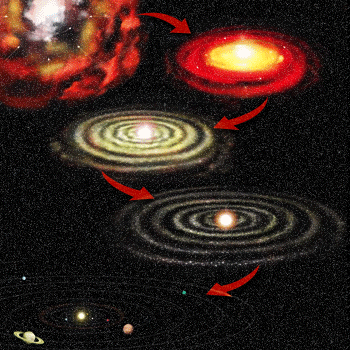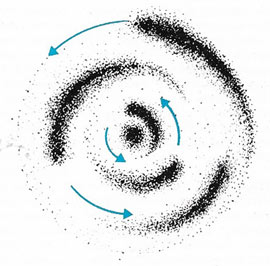nebular hypothesis

The nebular hypothesis is the idea first put forward in general terms by Immanuel Kant in 1775, and then more specifically by LaPlace in 1796, that the Solar System formed through the progressive condensation of a gassy nebula which once encircled the Sun. It was suggested that as this nebula rotated and contracted, rings of gas were cast off at various stages from which the planets subsequently condensed. Accordingly, the outer planets would have formed first, followed by Mars, Earth, Venus, and Mercury.
 |
| The nebular hypothesis, proposed by LaPlace, assumed that before the birth of the planets the Solar System consisted of a gas cloud which shrank, because of gravitational forces. This resulted in an increase in the speed of rotation and a ring separated from the nebula; the ring slowly condensed into a planet. Further rings were then thrown off, each producing a planet.
|
Although nebular hypothesis, as set out by LaPlace, proved unworkable, the notion of a sequential origin, from outermost planet to innermost, influenced subsequent debate about the nature of life on our neighboring worlds. In particular, it implied that Mars was more evolved than the Earth, so that if intelligent Martians existed they were likely be more advanced than ourselves (see life on Mars), whereas Venus, being a younger world, might support only primordial forms of life. The nebular hypothesis also implied, in sharp contrast with its great rival, the catastrophic hypothesis, that planets, and possibly life, around other stars might be common.
In updated form, the nebular hypothesis has become the consensus model of planetary origin (see planetary systems, formation).


